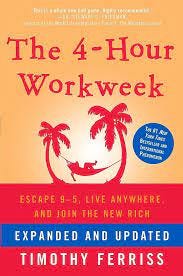“Do not overestimate the competition and underestimate yourself. You are better than you think.”
In 2001, Tim Ferriss, a 24 year-old tech salesman in San Francisco, started an online supplement company called BrainQuicken (“BQ”).
Within a couple years, Ferriss had made enough money to quit his job, and go into BQ full time. But it soon became all-consuming. Tim was burning out.
I had been slaving away with 15-hour days seven days per week, feeling completely overwhelmed and generally helpless. The next morning, I began a dissection of my business and personal life..
By necessity, Ferriss figured out how to systematize BQ, and automatize income while taking himself, more or less, out of company operations. The process worked so well that Tim increased revenue while working just four hours per week.
It was this experience that Tim wrote about in his best-selling book, The Four Hour Work Week (2009).
There are a lot of tactical pieces of advice, some of which that may become a subject of a future post. But, for me, it wasn’t as much the tactical pieces of the 4HWW that had the greatest impact, but, what I see as Ferriss’ underrated talent: showing us new ways to see the world.
One of which is the subject for today’s OGT.
How to achieve the “impossible”
In 2007, Ferriss was giving lectures on “high-tech entrepreneurship” at Princeton University.1
At the end of the lecture Tim laid down a challenge for the class, the winner of which would get a round-trip ticket anywhere in the world. Twenty people took him up on it.
The challenge was simple:
Contact three seemingly impossible-to-reach people—J. Lo, Bill Clinton, J. D. Salinger, I don’t care—and get at least one to reply to three questions.
The winner would be the person who got the result in the most impressive fashion. But there was no winner.
Of 20 students, all frothing at the mouth to win a free spin across the globe, how many completed the challenge? Exactly … none. Not a one.
Many excuses were given, but Tim felt they all boiled down to one fear:
There was but one real reason… It was a difficult challenge, perhaps impossible, and the other students would outdo them…Since all of them overestimated the competition, no one even showed up.
Here’s where it gets interesting.
The very next year, Ferriss offered the same exact reward and challenge, but with one key difference.
Tim told the second class about the first class—how no one did it because they figured it was too hard, and that if it wasn’t too hard, than everyone else would win.
Knowing that, the results for the second class were dramatically different.
6 out of 17 finished the challenge in less than 48 hours.
Tim’s explanation of the difference in mindset is the OGT:
From contacting billionaires to rubbing elbows with celebrities—the second group of students did both—it’s as easy as believing it can be done
Tim continues, reminiscent of Google’s Astro Teller and his 10x thinking:
It’s lonely at the top. Ninety-nine percent of people in the world are convinced they are incapable of achieving great things, so they aim for the mediocre. The level of competition is thus fiercest for “realistic” goals, paradoxically making them the most time- and energy-consuming…It is easier to raise $1,000,000 than it is $100,000. It is easier to pick up the one perfect 10 in the bar than the five 8s…
And the second reason was even more practical:
Having an unusually large goal is an adrenaline infusion that provides the endurance to overcome the inevitable trials and tribulations that go along with any goal. Realistic goals, goals restricted to the average ambition level, are uninspiring and will only fuel you through the first or second problem, at which point you throw in the towel. If the potential payoff is mediocre or average, so is your effort.
Tim’s through-line is one we might all benefit from:
If you are insecure, guess what? The rest of the world is, too. Do not overestimate the competition and underestimate yourself.
You are better than you think.
The OGT
Ferriss get’s credit for the tactical and the efficient, but, for me, his gift—one common to all OGTers— is the ability to change how he, and by extension we, see the world
The key idea is about belief. The second class finishing the challenge is like the famous story of Roger Bannister. Until Bannister, no one thought the four-minute mile could be broken. And then he did it. Then, seeing that it actually could be done, other people quickly followed. It took only what Tim says, “it’s as easy as believing it can be done.”
Tim’s other ideas are practical: (1) less people try for hard, seemingly impossible, things, so there’s less competition (2) hard things inspire greater enthusiasm to get through hard things.
So, expand your belief, try for the out of reach, and maybe you’ll have the enthusiasm to get there. Because, as Henry Ford said,
Whether you think you can, or you think you can’t—you’re right.
Now—go think on that.
Want more OGTs?
Here’s a clip from that lecture of Tim talking about avoiding multitasking





